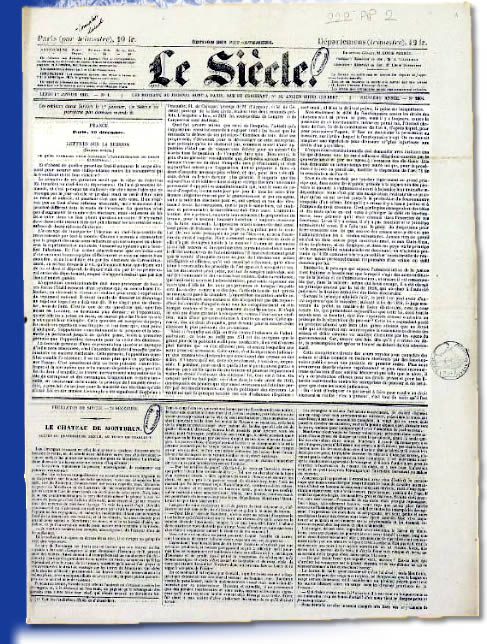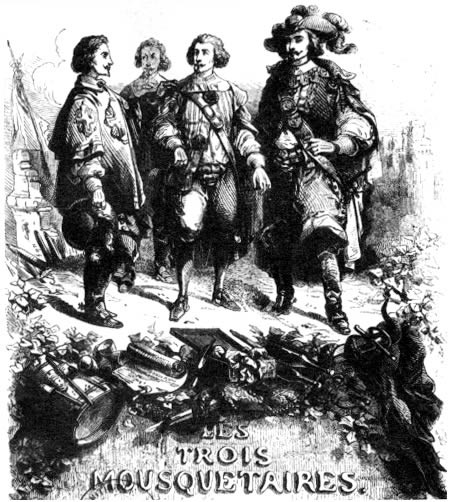The serialized novel was born in England in the eighteenth century, thanks to Daniel Defoe who whipped English readers into a frenzy with his adventures of a certain Robinson Crusoe.
The genre began to develop in France during the years 1830-1840 with the advent of an inexpensive press destined to a wide readership. This new form was the fruit of an ingenious and opportunistic alliance between talented novelists on the one hand and newspaper editors on the other, both camps finding considerable financial advantages in this collaboration.
For one, the novelists of the epoch did not have effective means to diffuse their works. The book-sellers-editors were not yet well organized, with rather high manufacturing costs, no real literary strategy and unprofitable reading rooms (a kind of paying library that gradually democratized access to books).
The series novel arrived just in time, promising to reach a wide audience while offering better financial perspectives.

At the same time, a new press was in full expansion. Two new newspapers appeared in 1836: La Presse, directed by Emile Girardin and Le Siècle, directed by Armand Dutacq, who both instituted a policy of reducing production costs while greatly increasing the number of readers. The two newspapers were in stiff competition to attract as many readers as possible, and the series novel became one of the stakes in this competition because of its ability to increase sales exponentially. The editors spent great sums to publish great novelists that could seduce the public… and sell their papers. And nothing could keep readers coming back for more like a hero or heroine in a perilous position!
And so the novel in series became a win-win situation for everyone, not least of all for readers.
All the great writers of the nineteenth century tried their hand at this new genre: Balzac, Georges Sand, Dumas, Eugene Sue, Soulié, Daudet, Gautier, Jules Verne, Zola, Féval… The authors also shared their success with their editors. Indeed, this preview of their works in the press proved to be a perfect way to launch a new book and a great source of publicity.
The success of the genre was such that writers could not just simply cut their books up into chapters for publication in instalments; rather, they were forced to adopt a special kind of writing adapted to this new form.
This new kind of publication posed certain challenges, for the authors had to write while keeping in mind limitations in the length of texts imposed by the newspapers and while frequently recapitulating the events in each instalment in order to refresh the reader's memory.
Too, each instalment had to end on a note of suspense in order to make the reader want to buy the next issue.
The serial writer found himself at the mercy of sales trends and even letters to the editor, for the public did not hesitate to react to a story and their voice could even change its outcome.
And so, a new writing technique appeared which called upon the author to adopt, in addition to the narrative cut up in newspaper instalments, other ingredients rather particular to this kind of literature: suspense, of course, but also frequent and dramatic turns of events, intense and sometimes frenetic action, struggle between good and evil, a cliffhanger at the end of every chapter, etc. And so, the author had to have a talent for harmonizing all these parameters while respecting a certain coherence in style and narrative.
The success of this new genre also encouraged copy-cats to jump into the act. And though the signature of an Alexander Dumas or a Eugene Sue at the bottom of a newspaper's front page could translate into an additional few thousand subscriptions, there were also literary hacks without talent.
For the latter, the constraints of the serialized novel proved fatal.
The multiplication of cliffhangers followed by sudden recoveries became predictable; the writing was rapid and sloppy; a coherent storyline sometimes took a back seat to intrigue; style was often inexistent.
For this reason, the serialized novel had its share of detractors who claimed that the genre sacrificed narrative substance in favour of easy, crowd-pleasing formulas and was a just a ruse to make money.

Even while this literary genre was greatly criticized and considered to be pulp for the masses, it nevertheless dominated the nineteenth century literary scene. Indeed, many authors won the praises of these very same critics.
Those who mastered the new genre and the conditions it imposed demonstrated a real genius, verve, creativity and a sense of intrigue and rhythm. These qualities, not given to everyone, resulted in the production of literature that actually made reading a pleasure. This genre could also be credited with developing a new readership among populations that had formerly been illiterate. It was also for this very reason that novels in series were pejoratively qualified as “popular”—because they were read by the lower classes.
The serialized novel can also be credited with inventing a certain kind of popular hero who has left his imprint on numerous generations, whether he is called d'Artagnan, Lagardère, Pardaillan, Rouletabille, Rocambole…
The new genre gave birth to a formula that consisted of a popular hero, adventure and romance and that would be the origin of a number of literary gems such as The Mysteries of Paris or The Three Musketeers . In fact, these two series appeared within one year of each other and were the respective secret weapons of two competing major newspapers. These works helped build the success of the serialized novel, a genre of which Balzac was so contemptuous and jealous at the same time (for it was not a genre in which he was skilled) and that others, such as Sainte-Beuve, denigrated.
These works also gave birth to a new genre. The Mysteries of Paris would be the harbinger of social tableau and The Three Musketeers was the precursor of the swashbuckler.
Life and death of the serialized novel
According to Lise Queffelec (The French Serialized Novel in the Nineteenth Century , PUF, collection “Que sais-je?”, 1999), there were three major periods of production for the serialized novel.
The first period, from 1836 to 1866, was that of Alexander Dumas, Eugene Sue, Paul Féval and Frederic Soulié who published novels that one could qualify as dramatic, impassioned, full of cliffhangers with a stereotyped hero that was self-appointed dispenser of justice and either a loner or marginal figure.
The second period, which ran from the end of the Second Empire to the beginning of the Third Republic (1860's to 1880's), was dominated first by Ponson du Terrail and then Féval, who continued in the same line, then Gaboriau, who was the precursor of the detective novel.
The third period is that of the expansion of the written press, which began around 1875. Newspaper circulation was beating all the records and serialized novels were generating more and more competition between authors. We even find a number of new genres during that time: the social novel, romance, historical fiction, crime, science fiction, exoticism. The authors are Michel Zévaco, Xavier de Montépin, Pierre Decourcelle…
It was at this time that editors like Tallandier launched collections of pulp fiction that were specialized in the genre.
After the two world wars and the arrival of other forms of media (cinema, radio, then television), the serialized novel gradually declined and then disappeared.
